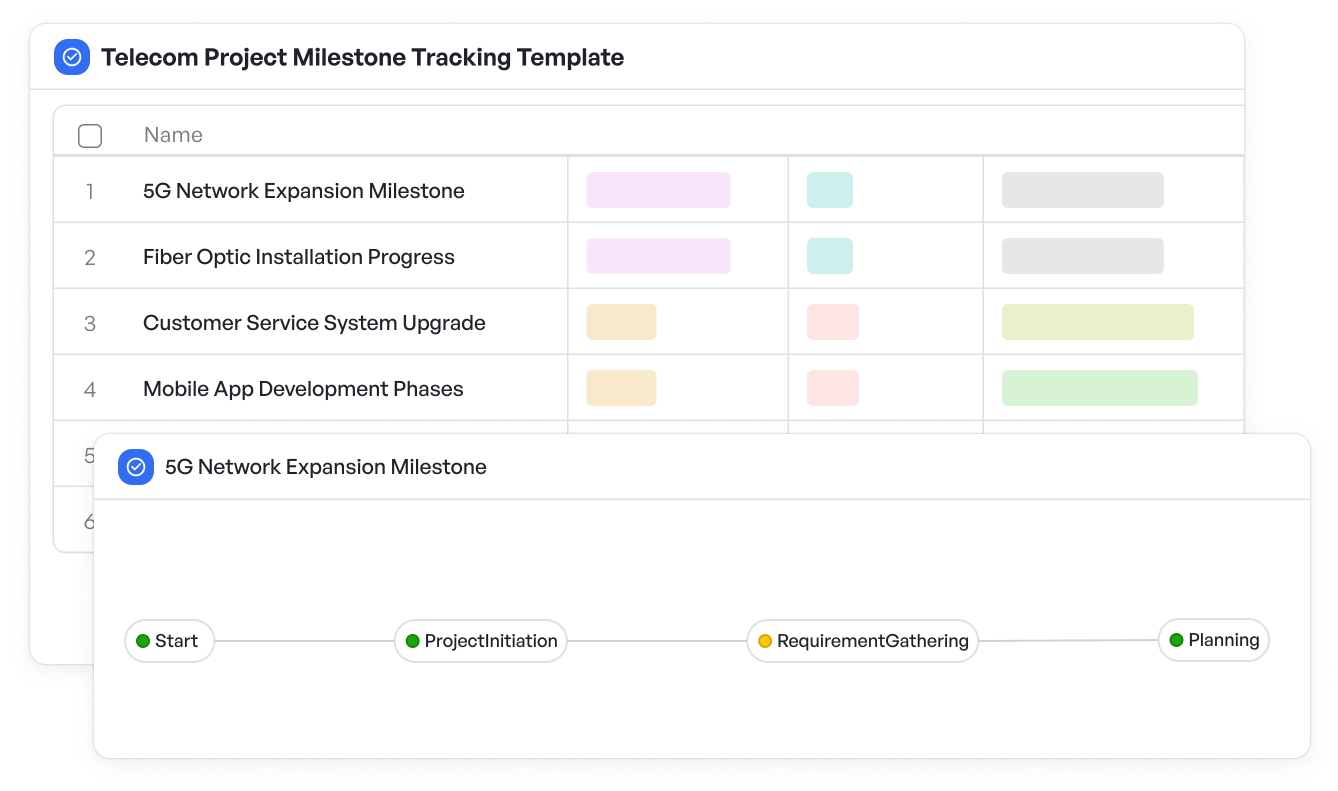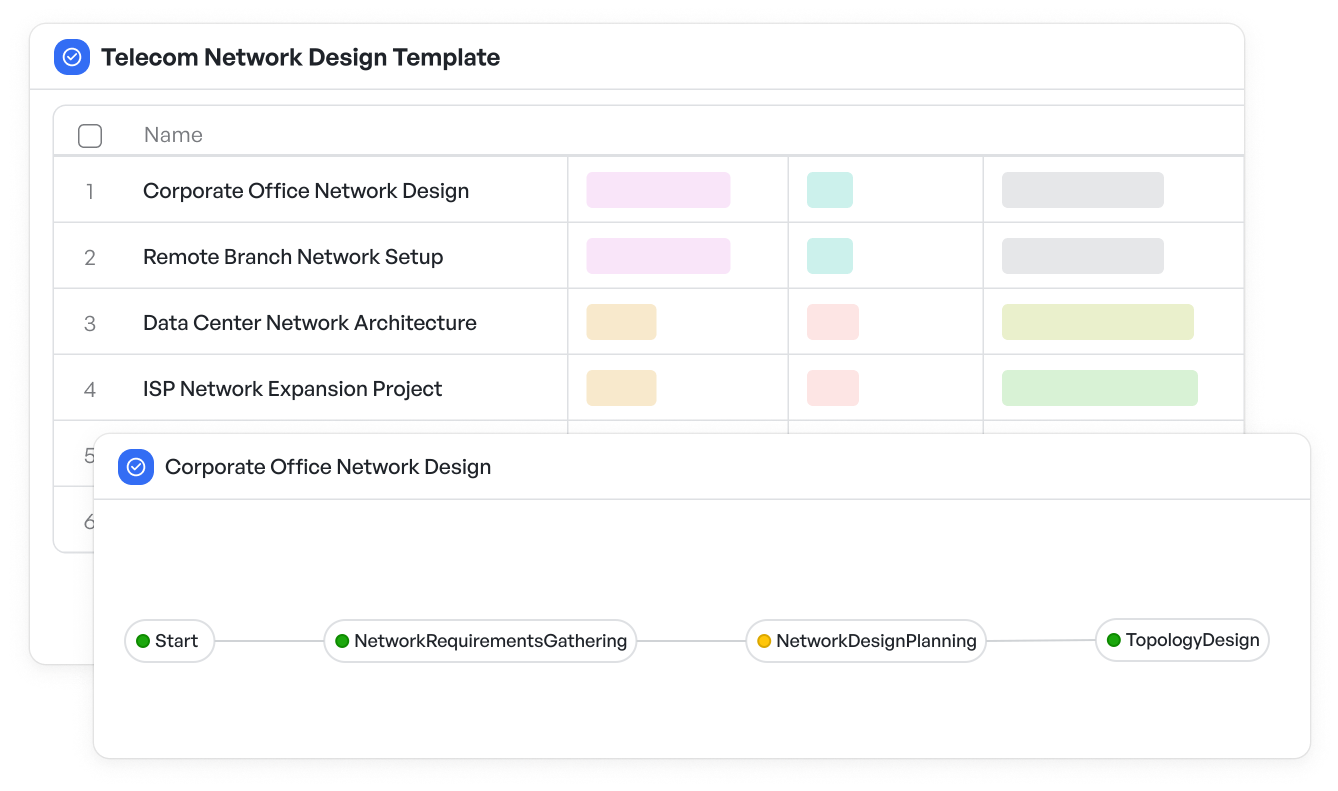How to Implement Feature-Driven Development in Telecommunications

The telecommunications industry is facing rapid technological shifts and growing customer demands, which require software and product teams to deliver updates quickly and reliably.
For mid-market and enterprise companies operating complex projects, adopting Agile methodologies tailored to telecommunications is essential.
Feature-driven development (FDD) provides a structured yet flexible approach that enables telecom teams to stay focused on delivering valuable, measurable features in iterative cycles.
This article explores the application of feature-driven development in telecommunications, highlighting its advantages, key steps, and how visual workflow management can improve collaboration and project transparency.
What is Feature-Driven Development in Telecommunications?
Feature-driven development is an Agile framework centered on breaking down complex projects into discrete, client-valued features. Unlike other Agile methods that emphasize broad iterations or stories, FDD focuses on producing tangible features that align directly with customer needs.
In telecommunications, this translates to delivering well-defined functionalities, such as network performance monitoring, billing system enhancements, or service activation modules, in precise and manageable increments.
To help organize and clarify these features, telecommunication teams often use tools like the telecom project scope definition template, which clearly outlines the boundaries and requirements of each feature.
By structuring development efforts around features, teams can better coordinate multiple disciplines involved in telecom projects, including software development, infrastructure, and operations.
 Clear feature scope with telecom project scope definition
Clear feature scope with telecom project scope definitionBenefits of Feature-Driven Development in Telecommunications
Telecom companies face several challenges in software development:
- Complex system integration: Telecom projects often involve interconnecting various systems and technologies.
- Regulatory and compliance requirements: Strict adherence to standards is mandatory.
- Fast time-to-market: Customer expectations and competitive pressures demand rapid delivery.
- Changing requirements: Network upgrades or customer feedback may lead to frequent scope adjustments.
To handle evolving requirements and maintain smooth coordination, telecom teams often rely on tools like the telecom project change management template. This template supports tracking feature adjustments and regulatory updates while improving communication across teams
 Change management is essential for handling regulations, system complexity, and shifting scopes in telecom projects
Change management is essential for handling regulations, system complexity, and shifting scopes in telecom projectsFeature-driven development addresses these by focusing on producing discrete, verifiable features that are easier to manage and review. The emphasis on feature design, development, and inspection cycles allows teams to adapt quickly while maintaining high quality.
Moreover, this approach facilitates clearer communication among cross-functional teams and stakeholders, reducing misunderstandings and bottlenecks.
Key Steps of Feature-Driven Development in Telecommunications
Implementing feature-driven development in telecommunications involves five key steps that guide telecom project teams from planning to delivery. These steps provide a clear structure while supporting Agile flexibility.
1. Develop an Overall Telecom Domain Model
Start by creating a high-level model that maps out telecom systems, workflows, and business processes involved. This domain model serves as a shared blueprint for all teams, fostering alignment.
To support this, teams often use the telecom infrastructure planning template, which helps visualize and organize complex network and system architectures effectively.
 Visualize and align telecom systems with a clear infrastructure blueprint
Visualize and align telecom systems with a clear infrastructure blueprint2. Build a Feature List
Break down the domain model into client-valued features. For example, “activate customer account,” “generate monthly usage report,” or “monitor network latency.”
Each feature is small enough to complete in a few days.
3. Plan by Feature
Prioritize features based on their business value, dependencies, and regulatory requirements. Then, develop short-term release plans aligned with product roadmaps and operational deadlines.
The telecom project timeline template and telecom project milestone tracking template offer practical frameworks for scheduling and monitoring feature delivery phases, keeping stakeholders informed.
 Track progress and keep milestones on schedule for timely feature delivery
Track progress and keep milestones on schedule for timely feature delivery4. Design by Feature
Create detailed designs for each feature, clarifying functional requirements, workflows, and technical specifications. This stage requires close collaboration across teams, especially given telecom’s multi-disciplinary nature.
Templates like the telecom network design and telecom network configuration are useful here, providing structure for design documentation and configuration planning.
 Structure detailed feature designs to streamline cross-team collaboration
Structure detailed feature designs to streamline cross-team collaboration5. Build by Feature
Implement, test, and deploy features iteratively. Continuous inspection and feedback loops ensure quality and allow for adjustment before full release.
This stepwise approach helps telecom teams maintain focus on delivering incremental value while managing complex project dependencies.
How Visual Workflow Management Supports Feature-Driven Development in Telecommunications
Managing large telecom projects often involves numerous teams working on interdependent tasks. Visual workflow tools can map these processes clearly, showing task progress, ownership, and timelines.
Using a visual workflow aligned with FDD provides these benefits:
- Full project visibility: Team members see ongoing features, their status, and how they fit into the broader project.
- Improved collaboration: Visualizing handoffs and dependencies helps coordinate work between software, network engineers, and operations teams.
- Faster problem identification: Bottlenecks or delays are easier to spot and address early.
- Streamlined communication: Stakeholders and decision-makers get real-time insight into progress without deep technical involvement.
 Workflow visualization in Meegle
Workflow visualization in MeegleFor telecommunications projects, where processes can be complex and tightly coupled, this clarity supports better Agile execution.
Aligning Feature-Driven Development in Telecommunications with Agile Practices
Feature-driven development complements broader Agile principles widely adopted in telecom software projects. It fits well with Scrum or Kanban workflows by providing a clear feature-centric focus.
Key Agile practices that work well alongside FDD include:
- Daily stand-ups: Brief status updates to discuss feature progress and blockers
- Sprint reviews: Demonstrate completed features to stakeholders for feedback
- Retrospectives: Reflect on development cycles to improve team performance
- Continuous integration and delivery: Automated testing and deployment of features to reduce time-to-market.
By combining FDD’s feature orientation with Agile ceremonies and automation, telecom teams can maintain steady delivery with high responsiveness.
Best Practices for Adopting Feature-Driven Development in Telecommunications
Successful adoption of feature-driven development in telecommunications requires attention to organizational and technical factors:
- Engage cross-functional stakeholders early: Ensure alignment between product management, software, network, and operations teams.
- Maintain a living domain model: Update the domain model regularly to reflect system changes or new requirements.
- Use modular architecture: Design features so they can be developed and tested independently, reducing integration risks.
- Incorporate compliance checks within features: Automate or include regulatory validation as part of feature development.
- Leverage workflow templates: Use configurable templates designed for telecom projects to accelerate setup and standardize processes.
Following these practices helps balance the complexity and pace of telecom projects with Agile discipline.
Deliver Reliable Telecom Projects with Feature-Driven Development
Feature-driven development provides telecommunications teams with a clear and measurable approach for managing complex software projects. By focusing on delivering client-valued features in iterative cycles, telecom companies can improve collaboration, maintain regulatory compliance, and accelerate product releases.
Visual workflow management further supports this by making project progress transparent and aligning multidisciplinary teams around shared goals.
For telecom leaders seeking a balance between control and agility in software delivery, applying FDD with structured workflows can drive meaningful efficiency and quality gains.
Try Meegle to simplify feature-driven development in telecommunications with visual, agile workflows.
The world’s #1 visualized project management tool
Powered by the next gen visual workflow engineRead More
Check All BlogsStart creating impactful work today



